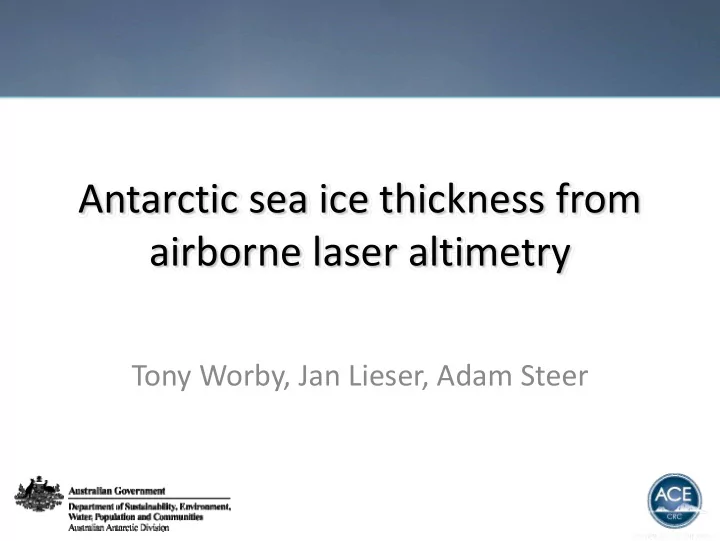

Antarctic sea ice thickness from airborne laser altimetry Tony Worby, Jan Lieser, Adam Steer
Antarctic Sea Ice Overturning circulation
Sea ice extent (in millions of sq km) ARCTIC Max: 16 Min: 6 - 7 Record min in 2007: 4 ANTARCTIC Max: 19 Min: 3 - 4 Source: NSIDC
Sea ice extent: Percent change per decade1979 - 2007 Arctic Antarctic Turner et al., 2009
SH sea ice concentration: trend for Autumn 1979 – 2007 Turner et al., 2009
From Stroeve et al, submitted Stroeve et al., Eos, 2008 Arctic circulation changed in late 1980s
Decline in Arctic sea ice thickness: 1958-76 to 1993-97 Rothrock et al., 1999
Much less is known about Antarctic sea ice thickness Worby et al., 2008
Courtesy: Jay Zwally ICESat Data over Antarctic Sea ice Sea Ice Thickness Snow-sea ice Freeboard Snow Depth (AMSR-E) Oct 4 - Nov 18, 2003 m cm m
AMSR ‐ E snow thickness compared with Antarctic field data ICESat and AMSR ‐ E data over Antarctic sea ice zone Field observations Factor of 2-3 Satellite data Worby et al. 2008b
Airborne sea ice research GPS Antennae Inertial Nav System (Location & Aerial Photo (Surface charact.) Orientation) Hasselblad H3D II 50 / Nikon D1x OXTS RT ‐ 4003 Scanning LiDAR (Surface elevation) Riegl LMS Q240i ‐ 60 Pyrometer (Skin surface temp.) Heitronics KT 19
LiDAR freeboard validation SIPEX Station 6: mean LiDAR : 0.24 m mean in ‐ situ : 0.25 m Worby et al., 2011
In situ measurements on Antarctic sea ice 100.0 50.0 0.0 0 10 20 30 40 50 60 70 80 90 100 110 120 130 140 150 160 170 180 190 200 -50.0 -100.0 -150.0 snow top ice top -200.0 bottom -250.0 Photo: Tony Worby
Ice thickness estimation Archimedes' buoyancy principle: mean LiDAR : 1.49 m ± 0.53 mean in ‐ situ : 1.15 m ± 0.67 Worby et al., 2011
Surface elevation questions In situ data Satellite radar data Giles et al., 2008 Worby et al., 2011
Conclusions • Accurate sea ice thickness is critical for climate model development (particularly ice thickness distribution) • Sea ice thickness retrievals from satellite altimetry require accurate snow thickness measurements • Surface topography also plays an important role in determining relative ice:snow thickness (different coefficients in buoyancy equation) • Combination of laser and radar altimetry are important to address key questions
Recommend
More recommend